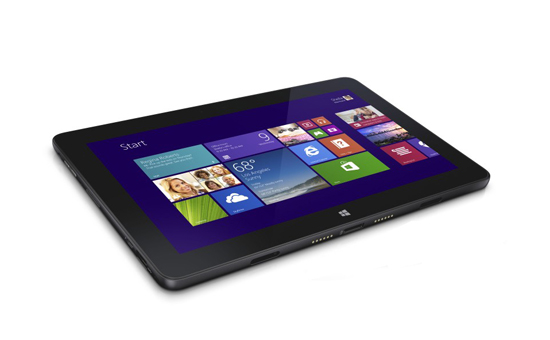In fact, the Dell Venue 11 Pro is actually a conventional Windows 8 tablet in the Surface mold, and it’s the accessories that you choose for it that allow it to be used as a desktop or laptop system. There are several different configurations available, with the basic tablet starting at £439 with an Intel Atom processor running at 1.46 GHz, 2 GB of memory, 64 GB of slow eMMC flash storage and the 32-bit version of Windows 8.1. The memory and storage can’t be upgraded later, although there is a model with an Intel Core i3 processor that includes 4 GB of memory and 128 GB SSD. This costs £619 on its own or £787 with the £168 docking keyboard. Dell also sells a basic keyboard without a battery for £52 and, as the Venue 11 Pro is intended primarily for business, there’s a number of warranty and support options available too. Our review unit was the cheaper Atom version and included Windows 8.1 Pro (32-bit) and a sturdy and comfortable keyboard dock that includes its own internal battery. Total price of £667. Regardless of configuration, all versions of the Venue 11 Pro have the same basic design, with a 10.8-inch screen and a weight of 770 g. That’s heavy for a tablet of this size, and you can still hold the tablet in one hand for short periods while you tap on the screen with the other. The screen has 1920 x 1080-pixel resolution, and produced a sharp and colourful image, although it is not using the usual IPS technology as we’d expect with a £400-plus tablet. And unfortunately, it wasn’t as bright as we might have liked, and there seemed to be relatively little difference between minimum and maximum brightness levels. The reason is that Dell has tried to lock down the backlit to almost unusably dim levels, almost certainly to inflate the battery life. If you fiddle long enough in Windows 8 you may be able to fix this. The display is fine for personal use when you’re browsing the web or watching some streaming video, but this is meant to be a business tablet and other people might struggle to get a clear view if you were using it for an impromptu PowerPoint presentation. It’s a similar story with the speakers, which produce a clear, detailed sound, but with poor volume levels. You’d certainly need to use headphones for listening to music, or external speakers for presentations in an office. Connectivity is also limited, with just a single USB 3.0 port, microSD and Mini HDMI located on the edges of the device. However, Dell does offer a desktop dock unit priced at £115, which provides gigabit ethernet, three additional USB 3.0 ports, and both HDMI and DisplayPort connectors to help out with presentations in the office. The Venue Pro includes an 8 Mp rear camera. A 2 Mp front-facing camera, which will be handy for video-conferencing when you’re out of the office. We were also pleasantly surprised by the performance of the Atom processor, which has clearly improved since its netbook days. The Intel Atom Z3770 used in the Venue 11 Pro is a quad-core 1.46 GHz processor that allows short-term Turbo speeds of up to 2.4 GHz. This Venue 11 Pro scored 2567 points when running the PCMark 7 benchmark test. That’s not going to break any performance records, but it means that the Venue 11 Pro is capable of basic computing tasks such as web browsing, presentations and running Microsoft Office (not included). The touch-screen controls responded quickly and smoothly, and even programs such as Word and Excel didn’t seem to be hindered by the limited 2 GB memory. Battery life was very good too. With its dim screen below our normal test setup levels, we got 9 hours (545 minutes) of streaming video when running the BBC iPlayer via Wi-Fi, close to Dell’s stated 10 hours – and that’s without the additional runtime provided by the battery in the optional keyboard unit. Another disappointment was that the Venue 11 Pro wouldn’t run our 3D graphics tests at all, so lunch-hour gaming sessions will be restricted to Angry Birds and similar lightweight 2D fare.
